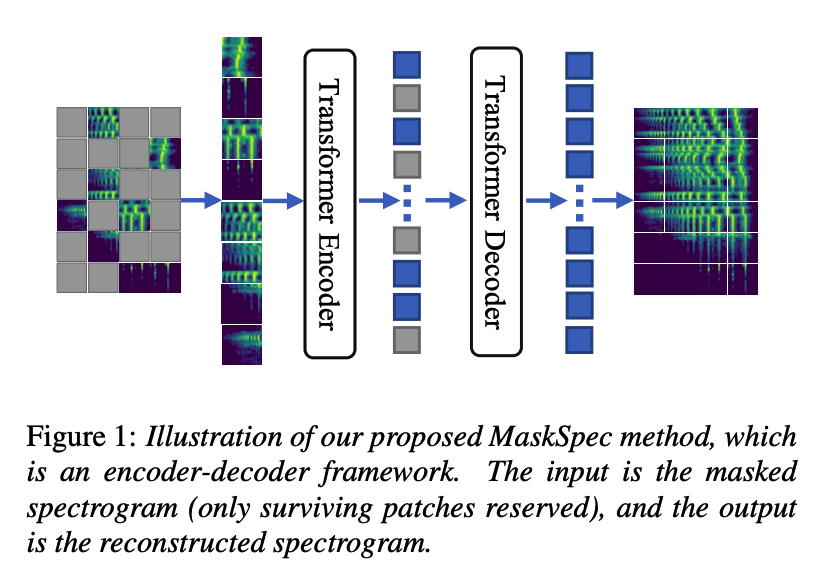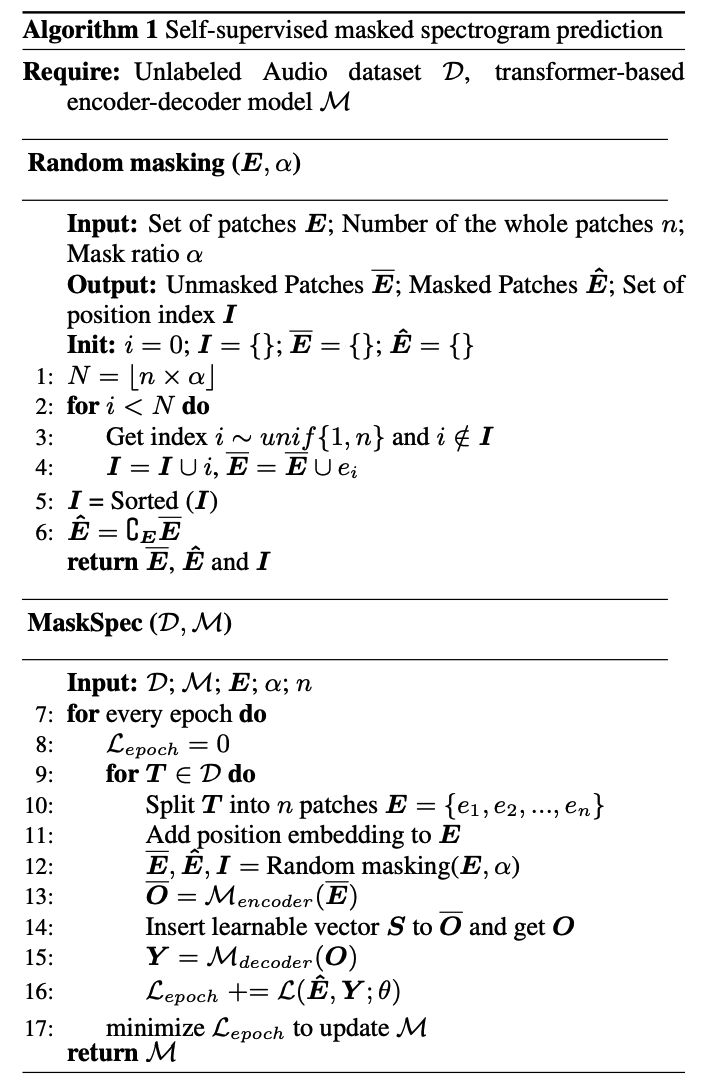Masked Spectrogram Prediction For Self-Supervised Audio Pre-Training (arxiv 2022)
https://arxiv.org/pdf/2204.12768.pdf
Contents
- Abstract
- Masked Spectogram Prediction (MaskSepc)
- Masking Strategy
- Encoder
- Decoder
- Implementation of framework
Abstract
Limitations of previous methods
- (1) pretrain using other domaines
- notable gap with the audio domain.
- (2) pretrain using audio domain
- currently do not perform well in the downstream tasks.
MaskSpec (masked spectrogram prediction)
- transformer-based audio models
-
SSL method uusing unlabeled audio data (AudioSet)
- procedure
- step 1) masks random patches of the input spectrogram
- step 2) reconstructs the masked regions
1. Masked Spectogram Prediction

Why input as spectogram ( why not raw waveform [20] or others ) ?
-
(1) spectrogram is sparse and contains abundant low-level acoustic information, and it has similar characteristics as the image, which has been proven to successfully adapt the transformer-based models
-
(2) spectrogram input provides the SOTA for many audio tasks [16, 24]
-
(3) spectrogram can be directly used as the input
( \(\leftrightarrow\) raw waveform often needs extra convolutional layers )
(1) Masking Strategy
Simple random mask strategy is effective and easy to implement.
Notation
- spectrogram \(\boldsymbol{T} \in \mathcal{R}^{N_t \times N_f}\)
- where \(N_t\) and \(N_f\) denote the number of frames and the frequency bin within one frame
- training sample of dataset \(\mathcal{D}\)
- a size of \(p \times p\) sliding window with the same hop size is first applied to get the patches \(\boldsymbol{E}=\left\{e_1, \ldots, e_n\right\}\)
- \(n\) : number of patches …. \(n=\left\lfloor\frac{N_t}{p}\right\rfloor \times\left\lfloor\frac{N_f}{p}\right\rfloor\).
- \(N=\lfloor n \times \alpha\rfloor\) : number of the masked patches,
- \(\alpha\) : masking ratio, where \(\alpha \in[0.05,0.95]\)
Different from the previous methods such as the masked patch sampling [22] …
\(\rightarrow\) directly remove the masked patches to make the pre-training efficient & keeps the position index of all the patches for the decoder to do the reconstruction.
(2) Encoder
same encoder architecture as PaSST (i.e. PaSST-Small and PaSST-Tiny)
\(\rightarrow\) called MaskSpec, MaskSpec-Small and MaskSpec-Tiny
Encoder is composed of …
- learnable linear projection
- stack of \(N_d=12\) transformer blocks.
- each block : \(N_h\) attention heads, \(N_{e m b}\) dimension of embedding and positionwise feed-forward network (FFN) with a hidden size of \(N_{f f n}\).
Settings
- MaskSpec : \(N_h=12, N_{e m b}=768\) and \(D_{f f n}=2048\).
- MaskSpec-Small : \(N_h=6, N_{e m b}=384\) and \(D_{f f n}=1536\).
- MaskSpec-Tiny : \(N_h=3, N_{e m b}=192\) and \(D_{f f n}=768\).
(3) Decoder
only used during pre-training ( for spectrogram reconstruction )
\(\therefore\) use a relatively lightweight decoder
( same decoder is used for MaskSpec, MaskSpec-Small and MaskSpec-Tiny )
Before feeding to decoder…
- step 1) Add masked vectors
- ( According to the position index ) insert shared and learnable vectors into masking regions of the output of the encoder & reassemble them
- step 2) Add position info
- inject information about the absolute position of the tokens in the sequence
Decoder is composed of …
- 8 layers of transformer blocks
- each block : 16 attention heads with the embedding size of 512 , and the feed-forward layers have a dimensionality of 2048.
- function of the last layer is to convert the output of the final FFN to the masked patches, in which each patch has a dimensionality of \(p \times p\).
- linear projection layer.
(4) Implementation of framework

[ Encoder ]
- step 1) input spectrogram \(\boldsymbol{T}\) is split into \(n\) spectrogram patches
- step 2) add position information to patches
- via sinusoidal position encoding
- step 3) randomly mask \(\alpha\) spectrogram patches
- masked index = \(\boldsymbol{I}=\left\{I_1, \ldots, I_N\right\}\).
- unmasked patches = \(\overline{\boldsymbol{E}}=\left\{e_i\right\}_{i \notin I_i}^{n-N}\)
- step 4) feed \(\overline{\boldsymbol{E}}\) into encoder
- output of the final hidden layers : \(\overline{\boldsymbol{O}}=\left\{o_i\right\}_{i \notin I_i}^{n-N}\)
[ Decoder ]
- step 5) fill each masked patch with a learnable vector \(\boldsymbol{S} \in \mathcal{R}^{N_{e m b}}\)
- result = input of the decoder \(\boldsymbol{O}=\left\{o_1, \ldots, o_n\right\}\).
- step 6) decoder & final linear projection layer map \(\boldsymbol{O}\) to the same dimension as the original masked patches \(\boldsymbol{E}\).
[ Loss function : MSE ]
\(\mathcal{L}(\hat{\boldsymbol{E}}, \boldsymbol{Y} ; \theta)=\sum_{i=I_1}^{I_N} \mid \mid \hat{E}_i-Y_i \mid \mid ^2\).
- masked patches \(\boldsymbol{Y}=\left\{y_{I_1}, \ldots, y_{I_N}\right\}\)
- reconstructed patches \(\hat{\boldsymbol{E}}=\left\{e_{I_1}, \ldots, e_{I_N}\right\}\)
